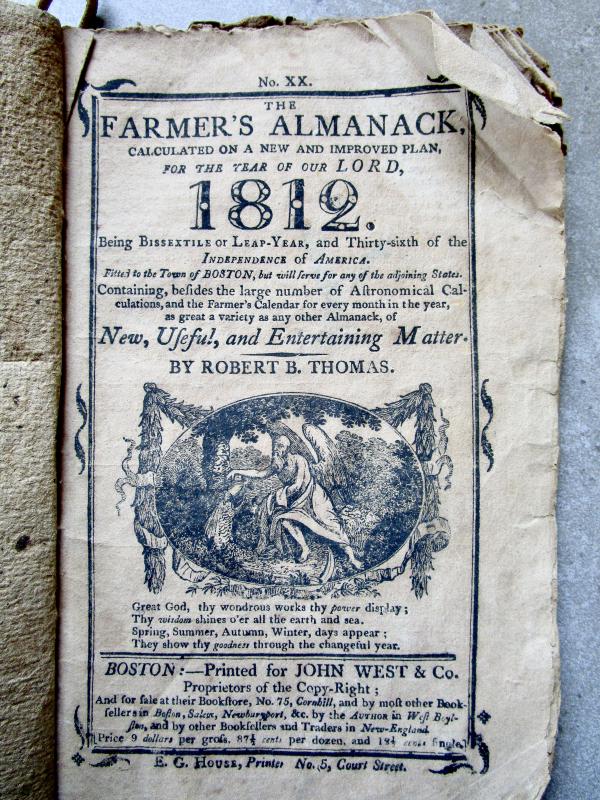An ‘almanack’ for 1812 turns up in Wiscasset
“Being bissextile, or Leap-Year, and the Thirty-sixth of Independence of America. Fitted to the Town of BOSTON, but will ſerve for any of the adjourning states. Containing, beſides the large number of aſtronomicl Calculations, and the Farmer’s Calendar for every month of the year, as great a variety as any other Almanack of New, Uſeful, and Entertaining Matter.”
So begins Robert B. Thomas’s curious FARMER’S ALMANACK for the year 1812, a Leap Year as he tells us with 366 days, when holidays after Feb. 29 are said to “leap” a day ahead on the calendar. The next leap year is 2024. After compiling his almanac, Thomas had it published by John West & Co., a bookseller and printer located on Cornhill Street, Boston where City Hall Plaza is now located. Before we continue, the odd-looking letter ſ resembling an “f” is a Colonial long “s.” Its uses eventually fell out of fashion when more modern typefaces were introduced.
Robert B. Thomas, the “B” stood for Bailey, or Bayley as the case may be, was a one-time schoolteacher. He later took up the trade of bookbinder and bookseller. Squire Thomas eventually changed the name of his publication to the Old Farmer’s Almanac that’s still published today, known for its distinctive manila cover and weather predictions. An online version is now available along with the traditional booklet.
Single copies of Thomas’s 1812 Farmer’s Almanack, “calculated on a new and improved plan,” sold for 12 1/2 cents. His opening acknowledgment to patrons and correspondents state this was his 20th edition. Thomas next acknowledges a minor error in his previous year’s almanac having listed the wrong date for a lunar eclipse. He also apologies for the quality of paper used in making his booklet. Actually, he used a rag-bond paper that’s held up rather nicely considering it’s 212 years old!
Why this copy was saved, who saved it, and for what purpose is a mystery. All I know for sure is that one day not long ago it turned up at the Wiscasset Transfer Station. A worker there saved it and gave it to Steve Christiansen of Willow Lane to add to his collection of historic memorabilia. Steve in turn loaned it to me to share parts of it with you. “It mentions Wiscasset several times, so maybe that’s why it was saved,” said Steve.
When most people think of the year 1812, they naturally think of the “War of 1812,” America’s second conflict with Great Britain. Congress declared war on June 18 of that year and the fighting lingered on until Feb. 18, 1815. During the war a number of captured British prisoners were housed in the new “Goal” located in Wiscasset. The three-story granite and brick jail had been completed the year before in 1811 and was said to be the most secure in Maine. But after being incarcerated, some of the captured British prisoners eventually escaped. The building and jailers’ house located at the upper end of Federal Street now serves as a museum operated by the Lincoln County Historical Association. Another Wiscasset point of interest from the same era is the 1813 Powder House that was built to store munitions during the War of 1812. The small round building built of bricks fired in Wiscasset occupies a small knoll surrounded by trees off Churchill Street.
Squire Thomas didn’t concern himself with politics, domestic or international. Instead he noted important dates for New England’s schools of higher education including Harvard, Middlebury, Providence and also Bowdoin College in nearby Brunswick. Listed were planned vacation closings and dates for commencements. He also noted court dates for the Commonwealth of Massachusetts. Maine, of course, was still a part of Massachusetts in 1812. Included among the court listings for the “District of Maine” are the city of Portland and Wiscasset, the Shire town of Lincoln County. From the almanac we learn the District Federal Court convened here on the first Tuesday in March, September and December. Cases were held in a wooden courthouse on the Wiscasset Common that’s long since gone. The present day Lincoln County Courthouse at the top of the Common opened in 1824 and is Maine’s oldest courthouse in continuous use.
Getting back to that 1812 almanac, monthly listings include astronomical calculations, phases of the moon, important calendar dates along with prose like on the page for the month of April: “Sweet is thy coming, spring! I love to pass Thy hedge rows, where from the half-naked spray peeps the sweet bud, and midst the dew grass. The tufted primrose opens to the day.”April’s weather was predicted to be “unsettled” with high winds and rain the first half of the month although warm and pleasant for Easter Sunday celebrated in 1812 on the 12th. To me this sounds kind of like the weather we’ve been experiencing.
Like present day almanacs, Thomas included helpful planting tips for farmers, or gardeners, stories of interest and clever anecdotes. There’s an article for eliminating the “canker worm,” a pest that attacked fruit trees. The unknown writer recommended wrapping the trunk with a linen cloth sprinkled with sea salt, rather than relying on a more proven method of applying pitch to the bark. There are suggestions, too, for clearing land and listings for the most favorable days for planting. Absent, at least from this edition, are the ever-popular cooking recipes and home-spun remedies.
Thomas’ 1812 edition was 18 bound pages, and measured 7 ¾ by 5 inches. It came with a looped lace attached to the booklet’s spine so it could be hung in a convenient place – the kitchen, the barn, or in the privy were folks carried out their morning business. Thomas included this odd riddle among the final pages:
With eyes above and eyes below,
Our maker did resign us;
We oft are with the low and mean,
But chiefly with polite men;
And full as often are we seen,
with all kinds of men…
We are not made of lead, or brass,
tin, copper, silver, gold ma’am.
Of steel of stone, of wood, or glass
So pray our names unfold, ma’am.
To learn the answer, readers needed to wait until publication of the 1813 Farmer’s Almanack.
Phil Di Vece earned a B.A. in journalism studies from Colorado State University and an M.A. in journalism at the University of South Florida. He is the author of three Wiscasset books and is a frequent news contributor to the Boothbay Register/Wiscasset Newspaper. He resides in Wiscasset. Contact him at pdivece@roadrunner.com






























